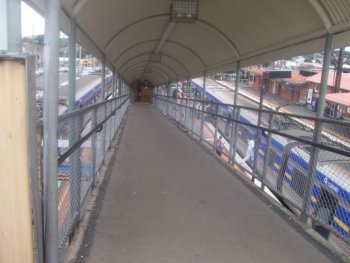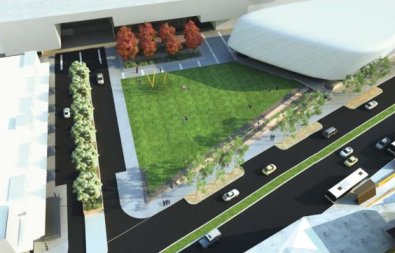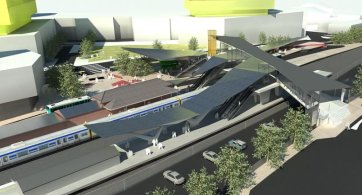The Eastern Transport Coalition represents one million residents across the seven eastern metropolitan councils within Melbourne’s eastern suburbs.
Today’s summit highlighted the need for public transport improvements within the eastern suburbs to become sustainable and accessible through providing transport choice for residents facing worsening traffic congestion and rising petrol prices. The theme includes the infrastructure needs of the region and included presentations on the need for new rail lines serving Rowville and Doncaster, as well as required improvements to the Belgrave and Lilydale rail lines.
The keynote speakers, Professors Peter Newman and Graham Currie, spoke about the importance of public transport in reducing greenhouse emissions and mitigating the effects of rising petrol prices. Both speakers reiterated the trend of rising petrol prices and demonstrated quite clearly that such increases were only going to continue.
While the Premier was unable to attend, Rob Hudson, the Parliamentary Secretary for Public Transport, stated that the Government would release a new transport plan by the end of the year. While the State Government released Meeting Our Transport Challenges in 2006, the plan was widely condemned as being inadequate and failed to plan for any infrastructure improvements in the eastern suburbs. It is hoped that the government’s next plan will rectify these shortcomings.
The Opposition Leader, Ted Baillieu, spoke about the government’s litany of public transport plans and the increasing cost of inaction. While the opposition leader did not make any commitments, he did highlight the need for rail lines to Doncaster and Rowville.
The summit was extremely well attended by community members, as well as local councillors, State MPs and members of local environment and transport groups. Time was provided to allow attendees to discuss the needs of the eastern region and during this time the need for accessibility improvements on public transport was mentioned.

I spoke on the needs of the Belgrave/Lilydale lines and Ringwood with Cr. Samantha Dunn from the Shire of Yarra Ranges, who spoke about the need for rail duplications to improve the reliability of the line.
My presentation focused on the need for rail improvements between Box Hill and Ringwood and the importance of Ringwood as a regional centre within the eastern region. The expectations of eastern Melbourne and its 1 million residents were conveyed at this summit. The State Government must act and deliver the much needed public transport infrastructure, including the redevelopment of Ringwood Station, that is urgently required for the region
Please continue reading to view a copy of the speech I delivered at the summit.

Travelling by rail Ringwood is 42 minutes away from the CBD or 15 minutes from Box Hill. During peak times, express services mean that a journey to the CBD is reduced to just 35 minutes.
The rail line currently has three tracks through to Box Hill, with two tracks covering the 9.6km between Box Hill and Ringwood.
The lack of a third rail line between Box Hill and Ringwood limits the ability to provide express services from Ringwood and limits the number of trains available during peak hour. By comparison Box Hill is served by an additional 23 trains and the third track would allow these services to continue through to Ringwood.
Furthermore the third track to Ringwood would provide the opportunity to run express services between Box Hill and Ringwood providing a faster journey by to 10 minutes for rail passengers. This will benefit not just Ringwood passengers, but also passengers further along the line.
Investing in rail improvements along the Belgrave/Lilydale rail corridor would not only improve public transport services across Melbourne’s busiest rail line but it would also facilitate the urban planning objectives of Melbourne 2030, particularly in regard to Ringwood.

The redevelopment of Ringwood Station is critical to ensuring the revitalisation of Ringwood. The current station fails accessibility standards (as defined by the Commonwealth DDA Act) and is perceived to be unsafe. Ringwood Station is consistently rated as one of the most unsafe locations within Maroondah. Narrow ramps, dark entrances and a pedestrian hostile environment are to blame.
Furthermore the redevelopment of the Station would facilitate traffic calming along Maroondah Highway allowing pedestrians to conveniently travel between the transport interchange and the residential/commercial precincts of Ringwood.
A number of residential and commercial developments have already occurred within Ringwood and the redevelopment of the station would facilitate further private sector investment. The redevelopment of Ringwood is no longer wishful thinking, the plans for the creation of a new town centre, expected to cost at least $600 million, were submitted to council last week. We now require the redevelopment of Ringwood Station to ensure that the full potential of this vision is achieved.

Coupled with the triplication of the rail line between Box Hill and Ringwood and the duplication of the single-track sections along the Belgrave and Lilydale lines, Ringwood could transform into a vibrant urban centre underpinned by public transport.
ABS journey to work data indicates that 15% of residents within the Ringwood transit city area use public transport and these improvements would further encourage public transport usage and reinforce the urban planning principles within Ringwood. Current data indicates that Ringwood residents do utilise public transport and more would do so if the infrastructure investment is delivered.
The Maroondah Highway pedestrian crossing is Maroondah’s busiest crossing with over 10,000 pedestrians per day. Despite its popularity pedestrians are required to wait up to two minutes to cross the road and often are forced to wait in the narrow median strip. The redevelopment of Ringwood Station would necessitate the calming of Maroondah Highway to transform it into a pedestrian friendly and vibrant hub.
Imagine shopping strips such as Burke Road, Camberwell with six lanes of traffic through it!
Given that the Melbourne average for public transport usage is 9%, it demonstrates that Ringwood residents are more than willing to use public transport when it is available and meets their needs. These figures also demonstrate the potential for public transport to underpin the revitalisation of Ringwood and the transformation into a vibrant regional centre.
The Ringwood Transit City will provide an immense benefit to the region, through a $16 million boost to Gross State Product which would enhance the liveability of the eastern region. This will only be achieved with the necessary investment in public transport through the transformation of Ringwood Station into an accessible and safe transit interchange.

A commitment towards Ringwood Station and planning for the third track is required to ensure that Ringwood and indeed the entire eastern region is Going Places.

Leave a Reply